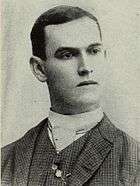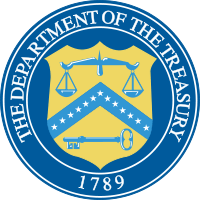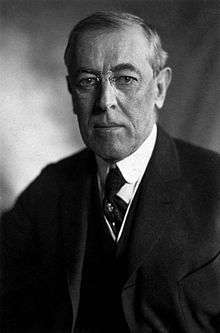David F. Houston
| David Franklin Houston | |
|---|---|
 Houston takes to University of Texas in 1910. | |
| 11th President of Texas A&M University | |
|
In office 1902–1905 | |
| Preceded by | Roger H. Whitlock |
| Succeeded by | Henry H. Harrington |
| 4th President of the University of Texas at Austin | |
|
In office 1905–1908 | |
| Preceded by | William L. Prather |
| Succeeded by | Sidney E. Mezes |
| 8th Chancellor of Washington University in St. Louis | |
|
In office 1908–1913 | |
| Preceded by | William S. Chaplin |
| Succeeded by | Frederic A. Hall |
| 5th United States Secretary of Agriculture | |
|
In office March 6, 1913 – February 2, 1920 | |
| President | Woodrow Wilson |
| Preceded by | James Wilson |
| Succeeded by | Edwin T. Meredith |
| 48th United States Secretary of the Treasury | |
|
In office February 2, 1920 – March 3, 1921 | |
| President | Woodrow Wilson |
| Preceded by | Carter Glass |
| Succeeded by | Andrew W. Mellon |
| Personal details | |
| Born |
February 17, 1866 Monroe, North Carolina, U.S. |
| Died |
September 2, 1940 (aged 74) Columbia Presbyterian Medical Center in New York City, New York, U.S. |
| Resting place | St. John's Church Cemetery, Oyster Bay, New York, U.S. |
| Political party | Democratic |
| Spouse(s) | Helen Beall Houston |
| Children |
Duval Houston David Franklin Houston, Jr. Elizabeth Houston Helen Houston Lawrence Beid Houston |
| Alma mater |
University of South Carolina Harvard University |
| Profession | Politician |
| Religion | Presbyterian |
David Franklin Houston (February 17, 1866 – September 2, 1940) was an American academic, businessman and conservative Democratic[1] politician.[2] He served under President Wilson as the 5th Secretary of Agriculture and the 48th United States Secretary of the Treasury.
Early life and family

Houston was born in Monroe, North Carolina, on February 17, 1866. He was the son of William Henry Houston, a horse dealer and grocer, and his wife, the former Pamela Ann Stevens. He graduated from the University of South Carolina in 1887 and did graduate work at Harvard University, where he received a M.A. in political science in 1892.[2] Houston married Helen Beall on December 11, 1895. They had five children: David Franklin, Jr., Duval, Elizabeth, Helen and Lawrence Beid Houston.
Higher education
Houston taught political science at University of Texas. He became an adjunct member of the faculty in 1894 and was named dean of the faculty in 1899. He then became president of the Agricultural and Mechanical College of Texas (now Texas A&M University) from 1902 until 1905. In 1905 he returned to UT to become that institution's president, serving until 1908. During his tenure at UT Austin, the school opened a doctoral program and a law school.[2]
Houston left Texas to serve as chancellor of Washington University in St. Louis, a position he held from 1908 to 1913. During his tenure he established the School of Architecture and strengthened the medical school through partnerships with Children's and Barnes hospitals. He left the university to become the U.S. Secretary of Agriculture.[2]
Under President William McKinley he was on the board of visitors of the United States Military Academy at West Point. Later in life, he was an overseer of Harvard University and on the Columbia University Board of Trustees.[2]
Politics and ready for Wilson's administration
Houston served as President Woodrow Wilson's Secretary of Agriculture from 1913 to 1920, when he became the Secretary of the Treasury until 1921.[3]
During his time as Agriculture Secretary many important agricultural laws were passed by the U.S. Congress, including the Smith-Lever Act, the Farm Loan Act, the Warehouse Act, and the Federal Aid Road Act.
Houston came to the Treasury Department as World War I was ending and his brief tenure was marked by stormy controversies over federal monetary policies. As ex officio Chairman of the Federal Reserve Board, he issued severe warnings and, increased rediscount rates in order to prevent the inflation that the European allies were experiencing. Houston predicted a fall in U.S. prices, particularly of farm products, after the optimism of the Armistice wore off. He pushed for easier credit for farmers and urged them to produce less.
But when prices fell more dramatically than expected in 1920, farm spokesmen unfairly accused Houston of deliberately wrecking agrarian prosperity. Abroad, England and France were pushing to cancel their war debts. Houston, the U.S. Congress and the President, against cancellation, converted the short-term debts to long-term loans. Houston resigned at the end of President Wilson's term, after only a year in office.
Business
After leaving the U.S. federal government, Houston became as the president of the Bell Telephone Securities and a vice president at AT&T. Houston also served as a director of AT&T, the Guaranty Trust Company and the United States Steel Corporation. He was president of the Mutual Life Insurance Company of New York for ten years.[2]
Death
Houston died of a heart attack on September 2, 1940 at Columbia Presbyterian Medical Center in New York City.[2][4] He was buried next to his wife at Saint John's Church Cemetery in Oyster Bay, New York.
Writings
Houston published A Critical Study of Nullification in South Carolina (1896) to establish his place in academia. He later published a two-volume memoir of his experiences as a cabinet member, Eight Years with Wilson's Cabinet.
References
- ↑ Elliot A. Rosen (2012). Roosevelt, the Great Depression, and the Economics of Recovery. University of Virginia Press. p. 68. ISBN 978-0-8139-3427-3.
- 1 2 3 4 5 6 7 "David Franklin Houston". Handbook of Texas Online. Texas State Historical Association. Retrieved 2011-04-07.
- ↑ "David Franklin Houston". Christian Science Monitor. February 3, 1920. Retrieved 2011-04-07.
The promotion, for such it must be regarded, of David Franklin Houston, for almost seven years Secretary of Agriculture in the Cabinet of President Wilson, ...
- ↑ "David F. Houston, Wilson's Secretary of Agriculture, Dies". Los Angeles Times. September 3, 1940. Retrieved 2011-04-07.
David Franklin Houston, 74, life insurance company executive, former educator and a member of Woodrow Wilson's Cabinet through the World War President's eight years in office, died at the Harkness Pavilion today after a brief illness.
External links
-
 Media related to David F. Houston at Wikimedia Commons
Media related to David F. Houston at Wikimedia Commons -
 Works written by or about David Franklin Houston at Wikisource
Works written by or about David Franklin Houston at Wikisource
| Academic offices | ||
|---|---|---|
| Preceded by Roger H. Whitlock |
List of Texas A&M University presidents 1902 – 1905 |
Succeeded by Henry H. Harrington |
| Preceded by William L. Prather |
President of the University of Texas at Austin 1905 – 1908 |
Succeeded by Sidney E. Mezes |
| Preceded by William S. Chaplin |
Chancellors of Washington University in St. Louis 1908 – 1917 |
Succeeded by Frederic Aldin Hall |
| Political offices | ||
| Preceded by James Wilson |
U.S. Secretary of Agriculture Served under: Woodrow Wilson March 6, 1913 – February 2, 1920 |
Succeeded by Edwin T. Meredith |
| Preceded by Carter Glass |
U.S. Secretary of the Treasury Served under: Woodrow Wilson February 2, 1920 – March 3, 1921 |
Succeeded by Andrew W. Mellon |


